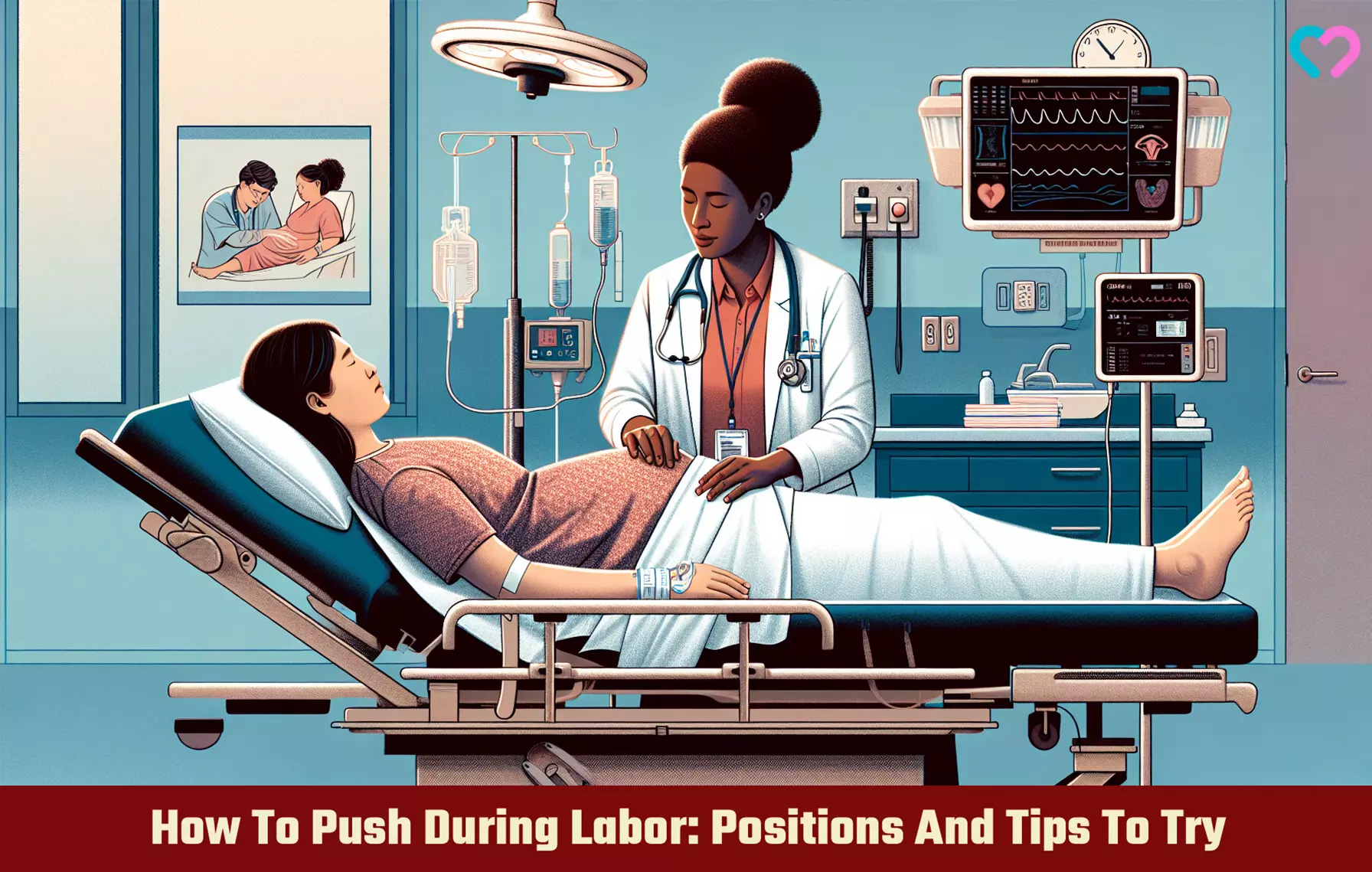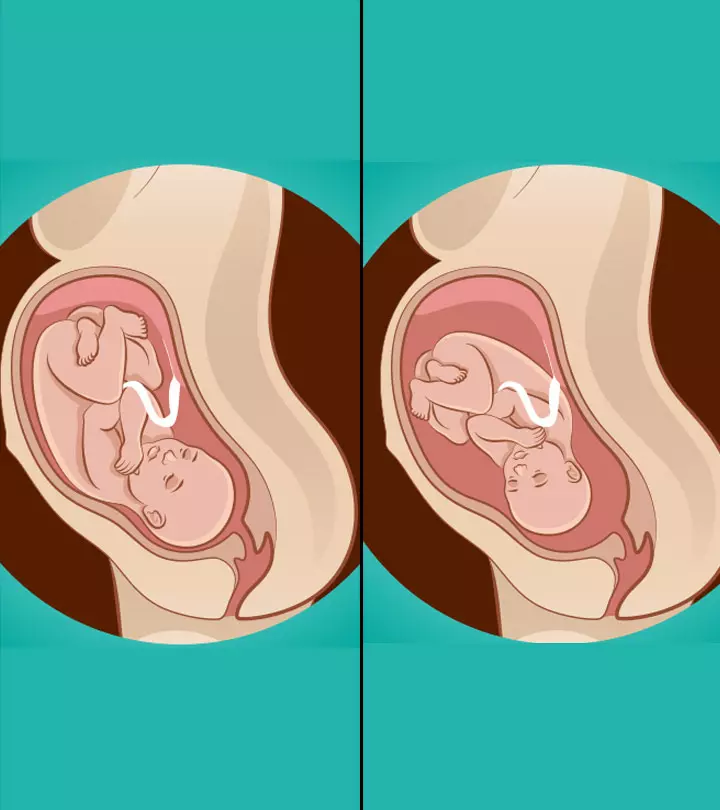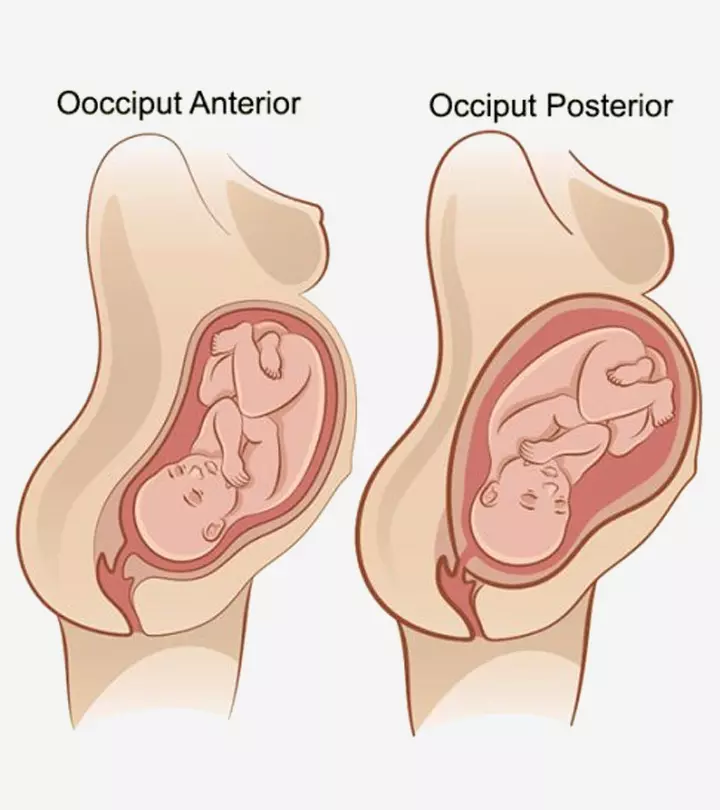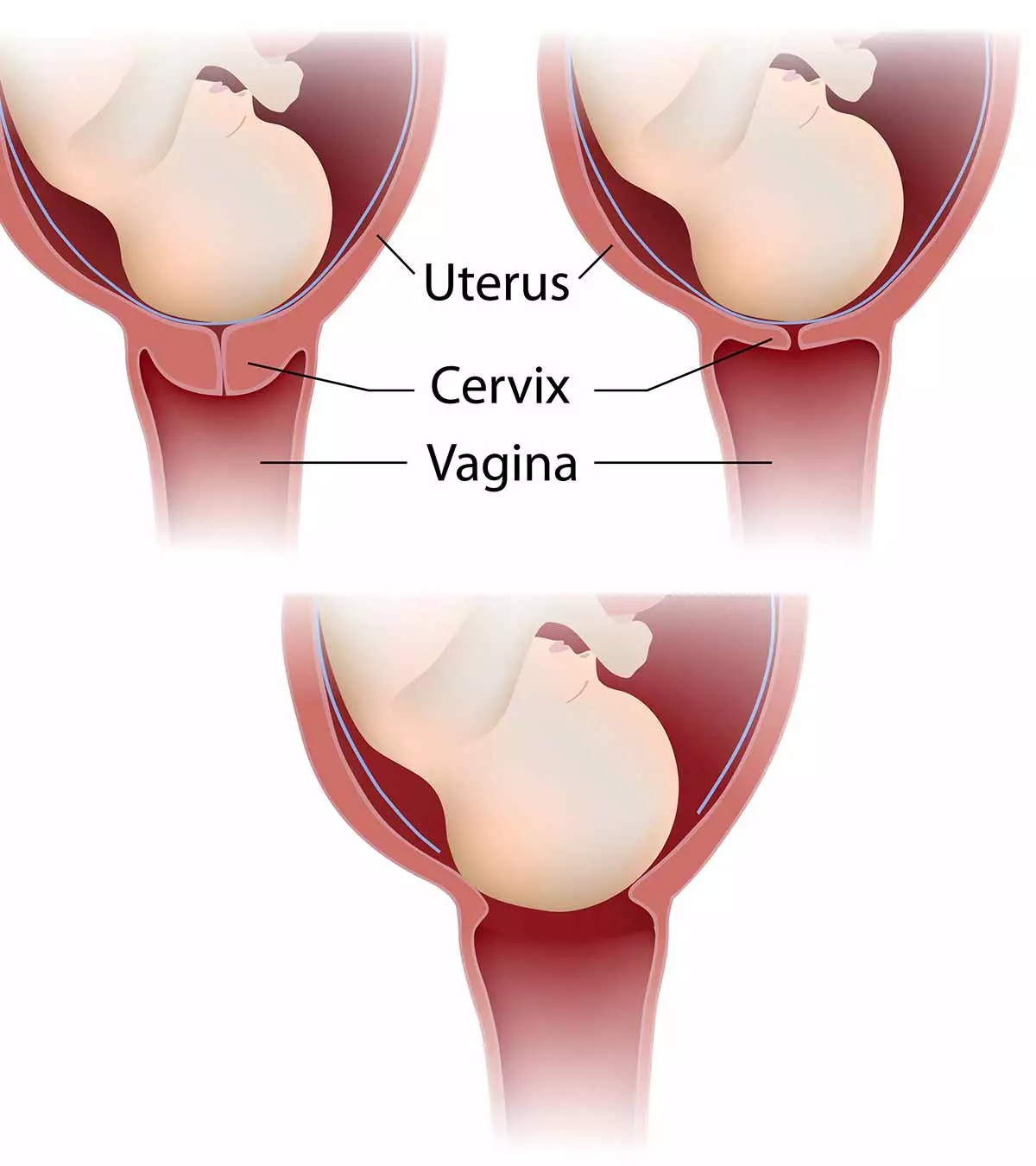
Image: Shutterstock
Many pregnant women are curious about understanding how to push during labor. Pushing during delivery is the second stage of labor, and most people describe it as the need to go to the toilet. The pushing phase occurs when the cervix is completely dilated and does not cover the baby’s head anymore. Then, as the body prepares for birth, a smooth passage is formed through the birth canal, from where the baby can come out.
Although pushing and delivering a baby is natural, it is intricate. Limited knowledge about its complexities often induces fear in expectant mothers, perhaps leading them to opt for a cesarean section. A World Health Organization (WHO) research reveals that the global prevalence of cesarean section births is steadily increasing, constituting over one-fifth (21%) of all deliveries (in 2021). While cesarean sections can be essential in specific cases, opting for the procedure without a medical reason may lead to unnecessary complications. Therefore, pregnant women should be aware of the intricacies of the labor and delivery process to make informed decisions and have a positive birthing experience.
This post provides you with complete information on when to start pushing the baby, how the contractions feel at this stage, whether the urge to push is natural or induced, how long you should push, and much more.
Key Pointers
- Various factors such as the baby’s position, the mother’s cervix dilation, and the presence of any medical conditions can influence the timing of pushing.
- Pushing can be performed in different positions, including lying on the back, squatting, sitting, getting on hands and knees, and lying towards one side.
- Controlled breathing and relaxation techniques can aid in effective pushing and pain reduction for the mother.
- The length of pushing can range from a few minutes to several hours.
- The healthcare provider will support and encourage the mother during the pushing stage while monitoring the baby’s well-being.
How Will You Know When To Push?
The doctor will check your cervix to determine the extent of dilation. Under labor induction, your cervix might dilate faster. Once the cervix dilates 10cm or completely, you are ready to push your baby out. You can feel the pressure of the baby’s head in between your legs, giving you a signal to push. The urge is so strong that most women feel better while pushing. Therefore, you push naturally and as hard as you feel is necessary (1).
You will feel:

- Increased pressure in the pelvic floor
- Strong urge to have a bowel movement
- Rush of adrenaline
- Pressure and heaviness in the vagina
- Your body is simply pushing under the influence of fetal ejection reflexiContractions in the uterus started by the placenta that causes women to push down a completely developed fetus.
If you are given an epidural, you will not have the urge to push. Your doctor will tell you when to push.
A mother and the author of The Happy Homemaker blog vividly recounts her childbirth experience. She describes, “Then the pain changed; it wasn’t any less, but there was this new feeling of wanting to push. I don’t know how else to explain that feeling. It’s a real sense of the baby ready to come out. It sort of distracts you from the severe pain of contractions. I was quickly rushed to the labor room, made to lie on a funny contraption in a position convenient for the doctor to catch the baby. This time, somehow, you welcome the wave of contractions, and with each contraction, everyone in the labor room, including doctors, nurses, and other helping ayahs, would scream “Push!” and I would push with all my might. Then the crowning happened!… With the next and final push with everyone in the room yelling, my gorgeous son Rohaan entered into our world at five thirty-nine in the evening (i).”
Pushing is coordinated by breathing and positioning so that the uterus works efficiently. In a few cases, the stage of pushing is long, and it begins even before you feel the urge. To prevent this long process of pushing, you should wait for the body to signal the urge. The 10cm dilatation does not mean you start pushing but you should allow the baby to move lower on its own.
Different practitioners have different philosophies. A few suggest that you should push when you have the urge so that it helps dilate the cervix. Premature pushing can cause caput formation (swelling in the subcutaneous planesiThe deepest skin layer located below the dermis. of the scalp) on the baby’s head.
A few others say pushing before the dilation can cause the cervix to swell, which will interfere with the birthing process. Early push can also cause a tear in the cervix. But there are no documented cases of cervical tear caused due to pushing before dilation.
What Triggers The Push?
The position of the baby triggers pushing in the majority of cases. Therefore, the urge comes from within. Your practitioner, midwife, or doula will tell you when to push, as they may want you to wait until the skin around the vagina adjusts to avoid any tears (2).
However, your body is the primary trigger element that signals when your baby moves low in the birth canaliA passage formed by the cervix, vagina, and vulva through which the fetus passes during the birth process. , accompanied by strong contractions.
Contractions During The Pushing Stage
During the pushing stage, the contractions are more regular than those in the advanced labor (transition phase). The uterus contracts every five minutes and each contraction lasts for 45 to 90 seconds. It is not easy to recognize the actual contractions, but you should try noticing a proper rest period between each of them.
The contractions are usually forceful and strong, and may or may not be associated with an urge to push. But you will definitely feel a renewed sense of energy as your baby nears the birth. At this moment, you should try relaxing all the body parts, except your tummy muscles, for your baby to arrive.
How To Push During Labor?
There are two different approaches to pushing in labor (3).
- Spontaneous pushing (physiological or mother-led pushing): This is recommended by most medical practitioners and midwives. In this method, you should wait for your body to signal, and you push when you feel the urge. This is mostly used during a water birth. It is also called the Lamaze technique and involves several steps that allow smooth childbirth. Since spontaneous pushing is a natural process, it potentially leads to lower stress levels, causes fewer interventions, and thus, ensures a safer birthing experience.
The WHO and the American College of Nurse-Midwives (ACNM) have recommended this practice as it benefits both the mother and the baby.
- Coached or directed pushing: This is a widely practiced method where you start pushing once you are completely dilated, irrespective of whether you have the urge or not. Your health practitioner or the midwife will instruct you to push.
Though directed pushing is a routine practice, experts believe that it is not advantageous either for the mother or baby. In fact, it could be otherwise for both.
 Quick fact
Quick factSpontaneous Pushing – How Is It Done?

In this approach, your midwife will ask you to listen to your body and try pushing whenever you feel like doing it. She may suggest you to do these:
- As contractions cause an urge to push, you should take deep, relaxing breaths and exhale.
- Try taking more breaths and push. It is quite okay to make noises like grunting and groaning while pushing but avoid shouting with your mouth wide open.
- Continue to take breaths every five to six seconds until you are told to stop the push or you no longer feel the urge. You should not hold your breath for long.
- The moment the urge is gone, take a relaxing breath and come back to a resting position until you get another contraction.
- When you feel the urge again, you can push for a few seconds during the peak of the contractions.
As the baby moves downward and puts pressure on the pelvic floor, you will feel like pushing more frequently and vigorously during contractions.
Coached Pushing – How Is It Done?
Coaching begins when the cervix has dilated to about 10cm, which is the second stage of labor, and continues until the baby is born. This stage lasts for a few minutes to many hours.
- Your midwife will ask you to take a deep breath at the beginning of each contraction, hold for a while and then push while tightening the abdominal muscles and exerting downward pressure. You should finish this one set as she counts ten. It is similar to the push you feel for a difficult bowel movement.
- Take a quick breath and push again while she counts another ten. Aim for three pushes for each contraction.
- To avoid the tear, you will be asked to hold back from pushing the moment your baby’s head is crowning. This is when the head, which is the widest part, is emerging through the vaginal opening (4).
Why Is Coached Pushing Done Even Though It Is Not Advisable?
Coached pushing has become a widely practiced method in the US birth centers. It is done to shorten the second stage of labor since early research has found that a long second stage is risky for the newborn.
The American College of Obstetricians and Gynecologists (ACOG) presented guidelines to determine when the second stage can be considered as prolonged. It can be after two hours without epidural for first-time mothers, after three hours with epidural for first-time mothers, and an hour less in each of the cases for second-time mothers.
The ACOG recommends practitioners or midwives do vacuum-assisted labor, forceps use, or a cesarean section if the second stage goes beyond the above-mentioned duration. It is not always necessary to intervene if both the mother and the baby are doing well. However, practitioners advise coached pushing to avoid intervention and prolonged second stage (5).
Research in the late 1970s showed that close monitoring of the baby during labor ensured the second stage did not affect the baby even when it lasted for more than two hours.
Coached Pushing – What Research Says
In a study published in 2006, where more than 300 women underwent labor without epidurals, it was found that there was an insignificant difference in the pushing stage (second stage of labor) in women who had coached push versus those who had spontaneous push. This study showed no benefit for the mother and the baby.
The same researchers previously published a report which showed that mothers who resorted to coached pushing had a high risk of urinary problems after three months. Spontaneous pushing did not show any adverse effects (6).
Coached pushing was also associated with one or more of the following:
- Higher chance of episiotomy or perineal tear.
- Increased risk of urinary and pelvic structural damage in mothers.
- Increased fatigue and stress in mothers – the push drains the energy that is needed later when you have to push under an urge
- Non-reassuring fetal heart rate patterns (which indicate fetal distress).
- High rates of vacuum-assisted or forceps births and C-sections.
- Coached pushing dismisses the woman’s instinct of how and when to push.
How To Push During Labor With An Epidural?

Epidural will greatly impact your push. If there is no sensation in the pelvic area, it would be difficult for the mother to feel an urge to push. You will also not be able to work with the contractions. It is especially difficult for the first time mother as she is not familiar with the push.
Your practitioner or the midwife will do a vaginal examination to see if the cervix is fully dilated. Then, she will ask you to push. If it is the right time, you may feel an increasing pressure in the vagina or pelvic floor. The other staff will monitor the push.
The midwife will watch for the contraction to peak and then tell you to push to utilize most of the contractions. She will also determine the baby’s position. In some cases, the epidural may wear off giving you an intense urge to push the baby. As long as there is a way for the baby to move down and contractions are enough, your body continues to lower the baby through the birth canal. It is also referred to as laboring down (7).
For the pushing stage to progress, you will get into a position that is comfortable and follow your practitioner’s instructions. You will be pushing at regular intervals, three times for a contraction or when you feel the urge. You might even want to take rest in between contractions if you are very tired.
What Does The Urge To Push Feel Like?
As your baby is moving lower through the pelvic floor, the pressure increases and a few women feel the need to push even before the cervix dilates.
You should focus on moving the baby downwards and not on pushing per se. You may want your baby to move lower as slowly as possible so as to have a gentle birthing experience. It is better for the baby to come slowly rather than push it out forcefully.
Usually, women in the pushing stage report of three different urges:
Overwhelming urge: It is an uncontrollable urge, and feels like your body is signaling that the baby is coming. It is tough to resist. You may be asked to stop pushing in case there are chances of complications like cord compression. A gravity neutral position will help decrease the urge so that the cord can be safe.
So-so urge: You will feel like pushing with every contraction or at the peak of contractions. It means the baby has not hit all the nerves to signal the uncontrollable urge to push. It can be best controlled by changing the position and breathing until you feel a strong urge. In a few cases, your baby may just move down with minimal effort, and you will not experience any strong urge to push.
No urge: It occurs in medicated births, and also if the mother or baby is not in a proper position. Time and positioning can help here. If dilation is complete for more than 30 minutes, then you can consider either ‘bearing down’ (instinct urge to push) or ‘direct pushing’ (coached pushing, where the other person directs). Also, there is no need to rush as long as both the mother and the baby are safe. The urge to push will happen gradually.
How Long Do You Have To Push In Labor?
The pushing stage lasts up to a few hours in women giving birth for the first time. And in those who are giving birth for the second or subsequent times, the pushing stage can last for as less as 20 minutes (8). In general, it can take a few minutes to hours to push the baby. The pushing time varies depending on the following factors.
If it is your first delivery or subsequent delivery: The pelvic floor muscles are tight if they have never been stretched to accommodate the baby to birth. Stretching will be usually slow and steady, and therefore takes time. If it is a subsequent delivery, it will take less time to push your baby. Women who have had multiple deliveries can push just once or twice because the muscles are prone to successive stretches.
Size and shape of the pelvis: Pelvic floor bones will vary in size and shape. A large oval opening is ideal. Some are small but neonates manage to get through them. In rare cases, openings are too small for the baby to come through. In this case, you will need more time to stretch the pelvis.
Size of the baby: Some babies will have skull bones that may not be in a good shape. So they usually shift and overlap during the labor. In such cases, the baby will be born with an elongated head, referred to as ‘cone head’. However, it returns to round shape in a day or two.
The baby’s head can be larger than your pelvic area, and cannot be known until the delivery is attempted.
Position of baby’s head in the pelvic floor: In a vaginal birth or normal delivery, the baby’s position should be headfirst to exit the womb. Facing back towards the tailbone will be an ideal position, which is referred to as anterior position. If the baby is facing towards the pubic bone, it is known as the posterior position.
In this position, the delivery will be slow, and the mother may experience severe back pain. Though babies can be delivered in a posterior position, they have to be rotated to an ideal anterior position sometimes.
Force of labor: Force usually refers to how hard the mother pushes and how strong the contractions are. Contractions help in dilation of the cervix, and if they dilate the cervix quickly, they also assist in birthing the baby easily. With a proper balance and push, your baby will be born within an hour or two with pushing. It may sometimes happen later or sooner too.
Stopping The Push – When Is It Required?

Sometimes, your practitioner may ask you to halt the push in a contraction even if there is an urge. It may be because your cervixiA muscular, tunnel-like canal that connects the uterus and the vagina. is not dilated completely, or your baby is crowning, and the perineumiThe sensitive area of skin between the genitals and anus. has to be stretched slowly. It may also be due to the evidence of fetal distress or cord compression (9).
Holding your urge to push is tough, but you should focus on your breathing here. Relax your shoulders, neck, and legs, and blow out or pant during the contraction. It is like blowing out candles.
Your partner can hold you, look directly into your eyes, and blow out or pant along with you to keep you from the push. You can also change the labor positions to control the urge.
Best Positions For Pushing During Labor
You can try various positions for pushing. Whatever the position may be, you should keep your chin down, and have a rounded back so that the abdominal muscles aid the uterus to push your baby.
The positions help significantly in progressing your labor, especially sitting and squatting positions where the gravity assists you. If your baby is coming out quickly, you can slow the stretching of the perineum by trying some other positions, like lying on one side or getting on your hands and knees, where the gravity acts neutral (2).
Squatting position:
- Helps open the pelvic region to a maximum width, up to one to two extra centimeters.
- Requires less bearing down to push.
- Gravity plays a key role.
- Very helpful if you do not have the urge to push
- Improves baby’s descent in a difficult delivery.
If you have any difficulty while squatting, you can try a semi-squatting position on a stack of pillows or a stool. You can also find birthing beds with attached squatting bars that offer you great comfort.
Semi-sitting or upright position:
- Gravity again plays a prominent role here.
- Your partner can help you by placing his hands on your lower back, and direct you to push towards his hands by tilting your pelvis. It allows the pelvic outlet to open to a maximum width.
- It can be done along with fetal monitoring
- It gives you a good resting position.
- Vaginal examination is easy in this position.
Sitting position:
- It is a good resting position.
- Is done along with fetal monitoring.
- Gravity is an advantage.
- Allows you to lean forward, which is a good position for relieving backache.
- You can try pushing on a commode as you will know how to push, and also it offers a firm surface.
Getting on hands and knees:
- Gravity is neutral and therefore slows a speedy delivery.
- Helps pain management by bringing the baby forward.
- Helps rotate the baby in the posterior position.
- Relieves pressure of the hemorrhoids.
Lying towards one side:
- Gravity is neutral and slows a speedy delivery.
- Good resting position.
- Allows vaginal examinations.
- It can be done along with fetal monitoring.
- Helpful in avoiding an episiotomy.
You can experiment with different positions until you find a comfortable position. For several women pulling a sheet or towel tied to the squat bar is comforting.
 Quick tip
Quick tip13 Tips That Can Help In Pushing Your Baby Out
Labor is not a time when you remember any tips or remedies. Therefore, learn a few easy-push tips even before you go into labor.
- Push as if you are having a bowel movement: Relax your thighs and body as if you are going to have the biggest bowel movement. Put all your focus and concentration on pushing, not worrying about whether you are passing urine or emptying your bowels.
- Tuck your chin to chest: If you are holding up to your back, ensure you keep your chin towards your chest for pushing. It helps you to focus on pushing whenever it is needed. It will also help you see beyond the navel region so you can understand where your pushes originate.
- Change the positions: If the push is not helping your baby move down for birth, changing different positions can help.
- Stay focused: Do not panic while pushing and try to control yourself. Do not strain your upper body or push with it. It can leave your eyes black or bloodshot and your face with bruises.
- Give all you have got: The more efficiently you push the more energy you will get to push, and the quicker you will have your baby pass through the birth canal.
- Rest after each contraction: You should conserve energy and therefore rest for the next contraction.
- Push and stop when you feel like: Your practitioner may ask you to stop the push for a few contractions to conserve energy or to keep the baby’s head from coming low too quickly. Instead of listening to them blindly, follow your senses.
- Check in a mirror: Watching your baby crowning can inspire you to push. You can see that in a mirror. Remember that the baby’s head may appear and disappear as pushing is a two-step process.
- Focus on pushing downward: If your eyes are bloodshot, face red, and neck muscles tight then it means your pushing force is not going down but up. You should focus on your abdominal muscles for pushing downwards. It is just like how you do when you are passing urine.
- Make noise: Pushing requires hard work, and there is no need to do it quietly. You can moan, grunt, or make sounds. High-pitched screams and noises will not help. They just move your energy upwards. You should instead make deep and low sounds helping to push downwards.
- Touch baby’s head: Once you see your baby’s head emerging out, you can touch it to direct your push. You will know that your baby is coming out.
- Empty your bladder: If you have not passed urine, your doctor may ask you to use the toilet before pushing.
- Breathing: Do not take long breaths, instead short breaths, and little push will ease your labor.
- Visualization: Visualization is a powerful technique that supports women during labor and delivery. Visualization techniques include meditation or thinking about a calm place that makes you feel peaceful. Moreover, visualization, birth affirmations, relaxation, deep breathing, self-hypnosis, and mindfulness can come together to help you through labor. This combination is known as hypnobirthing.
- Have liquids: You can sip liquids if you feel tired or thirsty.
How To Breathe While Pushing?
Breathing will help you stay calm and focused. Proper breathing will assist in contracting the muscles entirely. You will then utilize more muscles and gain the strength required for pushing. You may even use non-conventional techniques like listening to relaxation music or trying aromatherapy, massage therapy, and acupressure to regularize your breathing.
Keep your throat/jaw relaxed and mouth open: If you do not relax your throat or jaw, your perineum will also not relax. It is an involuntary action (which occurs without the conscious choice of the body), known as Sphincter Law, which you should completely avoid.
Place your hand just below your bust, on top of the abdomen: The moment you get the urge, tighten the abdomen by putting your hand on it. It relaxes the perineum.
Exhale by sending your breath downwards: You should not send out the breath through your mouth. You should flow it down. Say a whispered sound of ‘ah’ or ‘o’ as it helps to exhale. It relaxes your upper body and perineum as well. You can practice this skill way before to develop it automatically in labor.

Do not try to hold any sounds that could come spontaneously. Holding your breath can be damaging to you and your baby. However, if holding breath makes it easier for you to push, you can do it as long as you are comfortable.
What If Your Baby Does Not Deliver Even After Pushing Hard?
In some cases, your baby may need extra help to come out. Though you use all the strength and energy, it may not come, resulting in fatigue. Therefore, your push will not be strong enough to help in delivering your baby.
Your baby should be rotated in the right position. After a good pushing of two to three hours, your practitioner may guide your baby out using instruments while you continue to push.
She uses forceps or a vacuum extractor, but only when she can see the baby. Your practitioner will only guide the baby to come out while you push, but will not pull the baby out.
Minimize The Risk of Tearing
While baby birth positions are the primary thing in birthing the baby and reducing risks, perineal support is the next active factor.
- Perineal preparation can start in the previous months itself through kegel exercises (pelvic floor exercises) and daily perineal massage. There are also other techniques a practitioner may use during the time of delivery to keep your perineum intact.
- While the baby is reaching lower, warm compresses are directly applied to your perineum. It relaxes you and helps you to drift the baby down. Oil massage is also given to the perineal tissues for them to stretch slowly.
- If you have any perineal issues, you should discuss it with your obstetrician. She will ensure that the perineal supports are in place.
- Sometimes, you may require an episiotomy. However, research does not support this, and it is against ACOG guidelines. Tears are far better than episiotomies as they heal faster and involve only soft tissue. But episiotomies involve skin and muscle layers that may lead to scarring and incontinence in later life.
In a few cases, though the mother does not require an episiotomy, she may still need a few stitches. For repair of either tears or episiotomy, the practitioner may use dissolving sutures so that they do not require any removal later. You will also experience an itching sensation while the skin is healing.
When Do You Require An Episiotomy?
An episiotomy is a slit at the vaginal base that allows the baby to drift down easily. Earlier, it was believed that every delivery required an episiotomy for delivering the baby (10). However, about 70% of women experience a natural tear while giving birth. Episiotomies are performed under the following conditions:
- When there is a tear in the tissues that pass into sensitive regions like urethra and clitoris.
- When a baby is in distress and requires being brought out quickly.
- Even after pushing for a long time, there seems to be no progress.
- Perineal tissues are very tough
The need for episiotomy is not predictable. Certain factors like the size of your baby cannot be controlled. But other factors that can help control episiotomy are:
- Eating a healthy and balanced diet.
- Periodic stretching of the vaginal area at around four weeks before your delivery.
What Is Done After Your Baby’s Head Emerges Out?
While you are pushing, the practitioner or your midwife provides you support and continues to monitor your baby’s heartbeat. She will prepare you for the delivery by spreading sterile drapes, and rubbing your perineal region with an antiseptic. Once your baby’s head emerges out:
- the midwife will suction the mucus from the baby’s mouth and nose, and then gently pull out the shoulders and torso. You may be required to give one more push for this.
- she will then clamp the umbilical cord and cut it.
- your baby will be placed on your tummy or handed over to you. Your chest is the best place for helping your newborn transit to the outside life. Studies show that skin-to-skin contact helps babies sleep longer, stay calmer, grow better, and cry less (11).
It is then time for you to prepare for the very last push for delivering the placenta.
Frequently Asked Questions
1. What will be the baby’s role in being born?
Your baby plays a key role in labor progression. During delivery, the baby twists and turns to find the correct position to emerge out. It flexes its head to pass through the smallest birth canal. The still-soft plates of the baby’s skull will overlap one another on flexing so that it can come out quickly.
In some cases, the baby will not get the optimal birthing position. This scenario is an occiput posterior baby position. Here, the baby will face the mother’s abdomen instead of her spine, and it cannot flex its head into the smallest possible diameter. The baby may get wedged behind or against the pelvic floor, leading to a longer push stage. If you have severe backache during labor, it is mostly because of this position.
2. What is the resting stage in labor?
Some women, after the dilation to 10cm or more, will not feel any urge to push, and they will also stop having contractions. They go to rest or fall asleep (if there is no practitioner). This phase can last up to 30 to 60 minutes. There is no need to push and hurry the process under normal circumstances. However, most of the birthing centers have a backup plan, i.e., Pitocin (12). It is a drug that induces contractions so that the baby can be born on time.
3. What is the meaning of purple pushing?
Purple pushing is another name for the outdated technique of holding one’s breath, counting til ten, and then pushing. It is called so because your face may turn purple in color when you hold your breath. This technique may be risky as it can deprive one’s body of oxygen, cause a lot of stress to both you and your baby, and increase your risk of developing perineal tears (15).
4. Is it normal to feel a burning sensation while pushing during labor?
Yes, the vagina and cervix stretch and open during labor, which can cause a burning sensation (16).
5. How can a birth plan help prepare for the pushing stage of labor?
Birth plans give the expecting mother a sense of control and help doctors and midwives understand her preferences as she goes through labor. Birth plans clearly show how an expectant mother wants her labor and delivery to occur. However, the results cannot be guaranteed (17).
Although childbirth is a natural process, it is better to know some tips on “how to push during labor?” Fortunately, most midwives and gynecologists are around you during this natural childbirth to help you with the process. As you may have read, gynecologists follow different methods to help you push during delivery. Doctors may suggest squatting, or using birthing balls, or even a TENS machine during early labor. Moreover, nitrous oxide (popularly known as “laughing gas”) is gaining popularity in the US for pain management. Hence, your chosen method would come down to your and your gynecologist’s preference. Therefore, discuss the different pushing techniques with your medical practitioner in advance. It may also help to practice breathing techniques before delivery to help you stay calm and focused.
Infographic: Tips For Women Experiencing Labor
No matter how painful the contractions are, everything feels great for her once the baby is born and the mother holds the baby. But, there are some tips your doctor and midwife may suggest to push your baby out during vaginal delivery successfully. Check out the infographic below to learn about these tips.

Illustration: Momjunction Design Team
Illustration: How To Push During Labor: Positions And Tips To Try

Image: Dalle E/MomJunction Design Team
Breathing techniques are proven to be helpful during the tenuous process of labor in order to make it easier on the mother. Watch this video to learn six tips to have a successful vaginal birth.
Personal Experience: Source
MomJunction articles include first-hand experiences to provide you with better insights through real-life narratives. Here are the sources of personal accounts referenced in this article.
i. My childbirth experiences – normal delivery.
https://anjumobin.blogspot.com/2012/04/my-delivery-experience-miracle-of-birth.html
References
- Kathleen Rice Simpson; (2006); When and How to Push: Providing the Most Current Information About Second-Stage Labor to Women During Childbirth Education.
ttps://www.ncbi.nlm.nih.gov/pmc/articles/PMC1804305/ - Joyce T. DiFranco et al.; (2007); Care Practice #5: Spontaneous Pushing in Upright or Gravity-Neutral Positions.
https://www.ncbi.nlm.nih.gov/pmc/articles/PMC1948091/ - Pushing methods for the second stage of labour.
https://www.cochrane.org/CD009124/PREG_pushing-methods-second-stage-labour - Pushing Techniques Used by Midwives When Providing Second Stage Labor Care.
https://epublications.marquette.edu/cgi/viewcontent.cgi?referer=&httpsredir=1&article=1043&context=dissertations_mu - Unzila A Ali and Errol R Norwitz; (2009); Vacuum-Assisted Vaginal Delivery.
https://www.ncbi.nlm.nih.gov/pmc/articles/PMC2672989/ - Mattea Romano et al.; (2010); Postpartum period: three distinct but continuous phases.
https://www.ncbi.nlm.nih.gov/pmc/articles/PMC3279173/ - Promoting Effective Recovery from Labor.
http://websites.umich.edu/~umperl/Spontaneous%20Pushing.htm - What are the stages of labor?.
https://www.nichd.nih.gov/health/topics/labor-delivery/topicinfo/stages - Pushing: The Second Stage of Labor.
https://www.sutterhealth.org/health/pushing - Pushing: The Second Stage of Labor.
https://www.sutterhealth.org/health/labor-delivery/pushing#:~:text=The%20pushing%20stage%20occurs%20after - Episiotomy.
https://quality.healthfinder.fl.gov/ - Skin-to-skin contact.
https://www.unicef.org.uk/babyfriendly/baby-friendly-resources/implementing-standards-resources/skin-to-skin-contact/ - Oxytocin Injection.
https://medlineplus.gov/druginfo/meds/a682685.html - Breathing out and pushing during labour.
https://www2.hse.ie/pregnancy-birth/birth/giving-birth/breathing-out-pushing/ - 5 Different Birthing Positions to Try During Labor.
https://www.lancastergeneralhealth.org/health-hub-home/motherhood/your-pregnancy/5-different-birthing-positions-to-try-during-labor#:~:text=Giving%20birth%20on%20your%20side - All About Pushing During Labor
https://www.lamaze.org/Giving-Birth-with-Confidence/GBWC-Post/TitleLink/All-About-Pushing-During-Labor - Signs of Labor
https://gch.org/services/womens-maternal-health/pregnancy-information-center/signs-of-labor/#:~:text=During%20labor%2C%20your%20uterus%20pushes,feel%20a%20stretching%2C%20burning%20pain. - Making a birth plan
https://www.pregnancybirthbaby.org.au/making-a-birth-plan#:~:text=Birth%20plans%20help%20to%20give,and%20birth%20to%20take%20place.
Community Experiences
Join the conversation and become a part of our nurturing community! Share your stories, experiences, and insights to connect with fellow parents.
Read full bio of Dr. Vimee Bindra
Read full bio of Rebecca Malachi
Read full bio of Swati Patwal
Read full bio of Aneesha Amonz
















